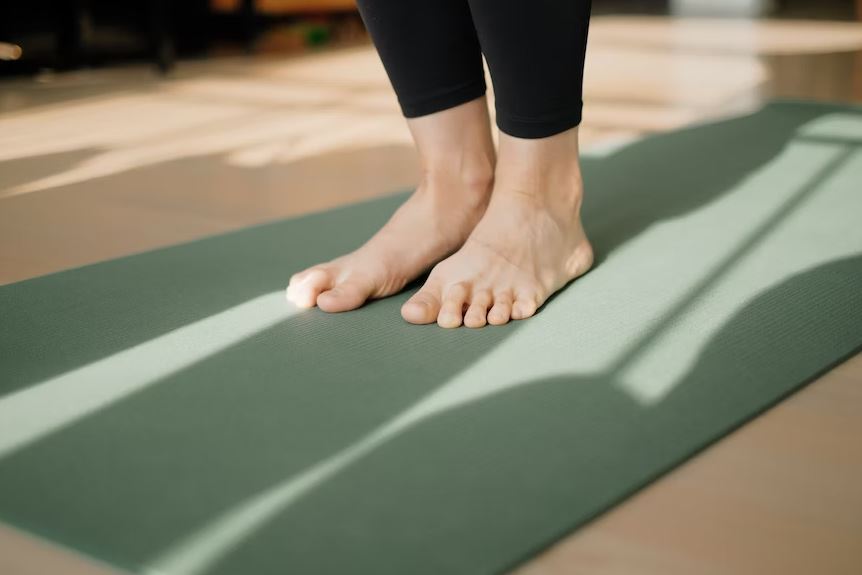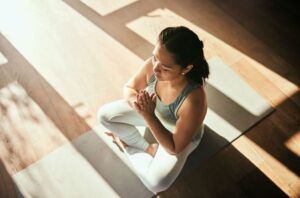Yoga has gained immense popularity in recent years as a holistic practice that promotes physical fitness, mental well-being, and spiritual growth. When it comes to practicing yoga, one essential accessory that often goes unnoticed but plays a significant role is the yoga mat. In this article, we will explore the importance of yoga mat and how it enhances the overall yoga experience.
Benefits of Using a Yoga Mat
Provides Cushioning and Support
A yoga mat acts as a protective layer between your body and the hard floor surface. It offers cushioning to your joints, such as knees and elbows, minimizing discomfort and the risk of injury. The softness of the mat allows for a comfortable practice, enabling you to focus on the poses and movements without distractions.
Enhances Stability and Balance
The grip provided by a yoga mat enhances your stability and balance during the practice. The textured surface of the mat prevents your hands and feet from slipping, allowing you to hold poses more effectively. With improved stability, you can confidently explore challenging asanas and deepen your practice.
Prevents Slipping and Injuries
Safety is paramount during a yoga session. A yoga mat with a non-slip surface provides a secure foundation, reducing the chances of slipping and sustaining injuries. Whether you’re performing dynamic sequences or holding static postures, the mat keeps you grounded and prevents accidental falls.
Creates a Personal Space
A yoga mat defines your personal space within a shared yoga studio or home environment. It serves as a boundary that separates your practice area from others, providing a sense of privacy and focus. This demarcation helps you concentrate on your own practice without being distracted by the surroundings.
Improves Hygiene and Cleanliness
Using a yoga mat promotes cleanliness and hygiene. It acts as a barrier between your body and the floor, preventing direct contact with dust, dirt, or germs that may be present on the surface. Additionally, most yoga mats are designed to be easily cleaned, allowing you to maintain a sanitary practice environment.
Choosing the Right Yoga Mat
Selecting the appropriate yoga mat is crucial to ensure comfort and optimal performance. Consider the following factors when choosing a yoga mat:
Consider the Thickness and Density
The thickness and density of a yoga mat determine its level of cushioning and support. Thicker mats provide extra padding, making them ideal for individuals with sensitive joints or those who prefer a softer surface. However, thicker mats may compromise stability and balance. It’s important to find a balance that suits your preferences and needs.
Look for a Non-Slip Surface
A key feature of a good yoga mat is its ability to provide traction. Look for mats with a non-slip surface that offers a firm grip. This ensures that your hands and feet stay in place, even during vigorous or sweaty yoga sessions. Opt for mats with textured surfaces or specialized grip technology for enhanced stability.
Assess Durability and Longevity
Investing in a durable yoga mat is essential, especially if you practice yoga regularly. Consider the material and construction of the mat to ensure it can withstand regular use without losing its shape or grip. High-quality mats may be slightly more expensive, but they tend to last longer and provide better value for money in the long run.
Consider Eco-Friendly Options
If sustainability is important to you, choose an eco-friendly yoga mat made from natural or recycled materials. Many brands now offer mats that are free from harmful chemicals, PVC, and latex. These eco-conscious options not only benefit the environment but also contribute to your overall well-being.
Determine the Appropriate Size
Yoga mats come in various sizes to accommodate different body types and preferences. Consider your height and the amount of space you require to move comfortably during your practice. A mat that is too small may restrict your movements, while an oversized mat may be cumbersome to carry and store. Find a size that suits your needs and allows for unrestricted movement.
Read More: Can You Do Yoga on Carpet Floor?
Maintenance and Care of Yoga Mats
Proper maintenance and care of your yoga mat are essential to ensure its longevity and hygiene. Follow these guidelines to keep your mat in optimal condition:
Regular Cleaning and Washing
Regularly clean your yoga mat to remove sweat, dirt, and bacteria. Most mats can be cleaned with a mixture of mild soap and water. Gently scrub the mat using a soft cloth or sponge, then rinse thoroughly and let it air dry. Avoid using harsh chemicals or abrasive materials that may damage the mat’s surface.
Proper Storage to Avoid Damage
Storing your yoga mat properly is crucial to prevent damage and maintain its shape. Roll the mat loosely with the top side facing outwards to avoid creasing. Avoid storing the mat in direct sunlight or extreme temperatures, as this can cause the material to deteriorate. Find a cool, dry place to store your mat when not in use.
Avoiding Exposure to Sunlight and Moisture
Excessive exposure to sunlight can cause the colors of your mat to fade and weaken the material. Similarly, moisture and humidity can lead to the growth of mold or mildew. To protect your mat, avoid leaving it exposed to direct sunlight for prolonged periods and store it in a dry area.
Using Mat Cleaners and Sanitizers
To maintain optimal hygiene, consider using mat cleaners or sanitizers specifically designed for yoga mats. These products effectively remove bacteria and odors, keeping your mat fresh and clean. Follow the manufacturer’s instructions for proper usage and avoid using harsh chemicals that may damage the mat.
The Connection Between Yoga Mat and Yoga Practice
The yoga mat serves as a fundamental tool that complements and enhances the yoga practice in various ways:
Enhances Focus and Concentration
Having a dedicated space marked by a yoga mat helps create a focused environment for your practice. It acts as a visual cue, signaling the mind to enter a state of mindfulness and concentration. When you step onto the mat, it becomes a sacred space where you can fully immerse yourself in the present moment.
Supports Alignment and Posture
A yoga mat provides a consistent surface that aids in aligning the body and maintaining proper posture. The lines and markers on some mats help you align your hands and feet accurately, ensuring the correct positioning for each pose. The stability provided by the mat allows you to explore and deepen your practice with confidence.
Promotes Mindfulness and Relaxation
The tactile sensation of the mat against your skin can deepen your awareness of the body and promote a sense of grounding. As you move through the practice, the mat becomes a source of comfort and stability, encouraging relaxation and surrender. It serves as a safe space where you can let go of external distractions and connect with your inner self.
Enhances the Overall Yoga Experience
Using a yoga mat significantly enhances the overall yoga experience. It provides a comfortable and supportive surface that allows you to fully engage with the practice. Whether you’re practicing gentle stretches or challenging inversions, the mat becomes a trusted companion that encourages exploration, growth, and self-discovery.
Yoga Mat Accessories and Enhancements
Beyond the mat itself, several accessories and enhancements can elevate your yoga practice:
Yoga Mat Towels for Extra Grip
If you tend to sweat profusely or practice hot yoga, a yoga mat towel can provide additional grip and absorption. These specialized towels are designed to be placed over the mat, offering a non-slip surface that keeps you stable and comfortable throughout your practice. They are easy to wash and maintain, providing an extra layer of hygiene.
Mat Straps and Bags for Convenience
To facilitate transportation and storage, consider investing in a mat strap or bag. Mat straps are lightweight and adjustable, allowing you to securely fasten your rolled-up mat for easy carrying. Mat bags provide a larger storage space and often have additional pockets for your personal belongings, such as keys, water bottles, or towels.
Mat Sprays for Freshness and Hygiene
Mat sprays are formulated to cleanse and refresh your yoga mat, providing a pleasant aroma during your practice. These sprays help eliminate bacteria, neutralize odors, and enhance the overall cleanliness of your mat. Choose a spray with natural ingredients and a scent that uplifts your mood.
Customization Options for Personalization
Many yoga mat brands offer customization options, allowing you to create a mat that reflects your personality and style. You can choose from a variety of colors, patterns, and designs to find a mat that resonates with you. Customizing your mat adds a personal touch and makes your yoga practice even more enjoyable.
The Importance of Using a Yoga Mat for Different Types of Yoga
While yoga mats are beneficial for all types of yoga, their importance may vary based on the specific style of practice:
Hatha Yoga
Hatha yoga, which focuses on physical postures and breath control, often involves static holds and gentle movements. Using a yoga mat provides stability, comfort, and support during these poses, allowing you to fully relax and concentrate on the breath and body alignment.
Vinyasa Yoga
Vinyasa yoga emphasizes flowing movements and transitioning between poses in coordination with the breath. A yoga mat with a non-slip surface is particularly important in vinyasa practice, as it ensures stability and prevents the hands and feet from sliding during the dynamic sequences.
Bikram Yoga
Bikram yoga, also known as hot yoga, is practiced in a heated room. The high temperature intensifies sweating, making a non-slip yoga mat essential to maintain balance and prevent injuries. Look for mats designed for hot yoga that offer enhanced grip and are moisture-resistant.
Ashtanga Yoga
Ashtanga yoga follows a set sequence of dynamic poses that require strength, flexibility, and focus. A supportive and non-slip yoga mat is crucial for practicing Ashtanga, as it enables you to move through the series with stability and confidence, even during challenging asanas.
Restorative Yoga
Restorative yoga focuses on relaxation and gentle stretching, often involving long-held poses supported by props. While the intensity of physical effort may be lower in restorative practice, using a soft and comfortable yoga mat enhances the overall comfort and relaxation during the restorative poses.
Alternatives to Yoga Mats
Although yoga mats are widely used and recommended, there are alternative options available if a mat is not accessible or suitable for your practice:
Yoga Rugs
Yoga rugs are traditional alternatives to mats, commonly used in India. Made of cotton or wool, these rugs provide a non-slip surface and cushioning. They can be used directly on the floor or layered on top of a mat for added support. Yoga rugs are particularly useful for practitioners who prefer a more traditional and tactile experience.
Blankets or Towels
In the absence of a yoga mat, blankets or towels can be used as temporary substitutes. Folded blankets or towels provide some cushioning and help prevent direct contact with the floor. However, it’s important to note that these alternatives may not offer the same level of stability and grip as a dedicated yoga mat.
Grass or Sand
If you prefer practicing yoga outdoors, grass or sand can serve as natural alternatives to yoga mats. The softness of grass or sand can provide a gentle cushioning effect. However, ensure the surface is clean and free from sharp objects or debris that could cause discomfort or injuries.
Carpets or Rugs
Indoor practitioners may choose to practice on carpets or rugs instead of yoga mats. While these surfaces offer some level of cushioning, they may not provide the same stability and grip as a yoga mat. Take caution when practicing on carpets or rugs to avoid slipping or accidentally damaging the surface.
Conclusion
A yoga mat is an indispensable tool that enhances the practice of yoga. It provides numerous benefits, including cushioning, stability, hygiene, and personal space. By choosing the right mat, maintaining it properly, and exploring various accessories, you can optimize your yoga experience and deepen your connection with the practice. Embrace the importance of a yoga mat, and let it become a supportive companion on your journey to physical and mental well-being.
Read More: Benefits of Private Yoga Lessons
FAQs
-
Q: Can I use a regular exercise mat instead of a yoga mat?
- A: While a regular exercise mat may offer some cushioning, it may not provide the same level of grip and stability as a dedicated yoga mat. Yoga mats are specifically designed for the needs of yoga practice, so it’s recommended to use a mat specifically designed for yoga.
-
Q: How often should I clean my yoga mat?
- A: It’s recommended to clean your yoga mat after every few uses, especially if you sweat a lot during your practice. Regular cleaning helps maintain hygiene and extends the lifespan of your mat. Follow the manufacturer’s instructions for cleaning and care.
-
Q: Can I practice yoga without a mat?
- A: Yes, you can practice yoga without a mat. However, using a yoga mat offers numerous advantages, including cushioning, grip, stability, and hygiene. If you prefer not to use a mat, consider alternatives such as yoga rugs, blankets, or practicing on grass or sand.
-
Q: How do I choose the right thickness for a yoga mat?
- A: The thickness of a yoga mat depends on personal preference and specific needs. Thicker mats offer more cushioning, which can be beneficial for individuals with joint sensitivities. Thinner mats provide better stability and balance. Test different thicknesses to find the one that suits your comfort and support requirements.
-
Q: Can I use a yoga mat for other exercises besides yoga?
- A: Yes, yoga mats can be used for various exercises and activities that require cushioning and grip, such as Pilates, stretching, or core workouts. The versatility of yoga mats makes them a practical choice for a wide range of fitness and wellness practices.



